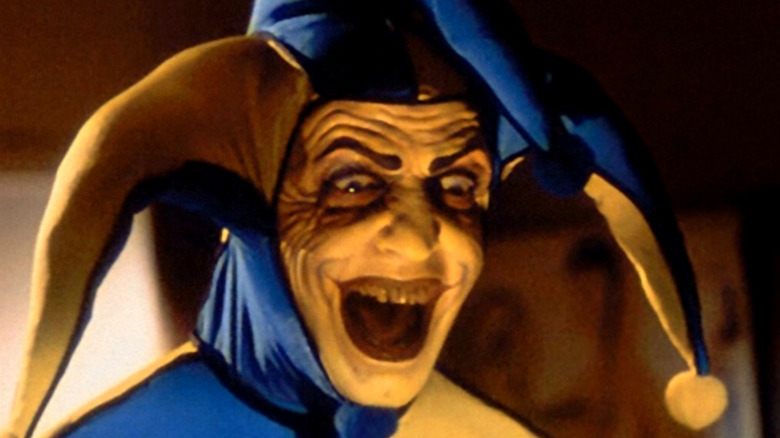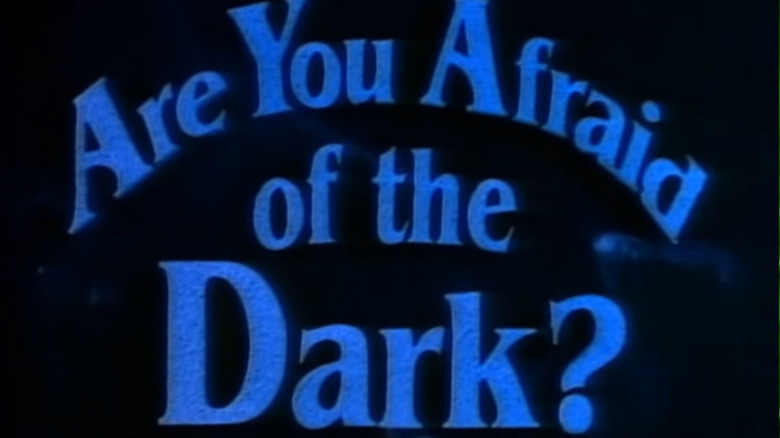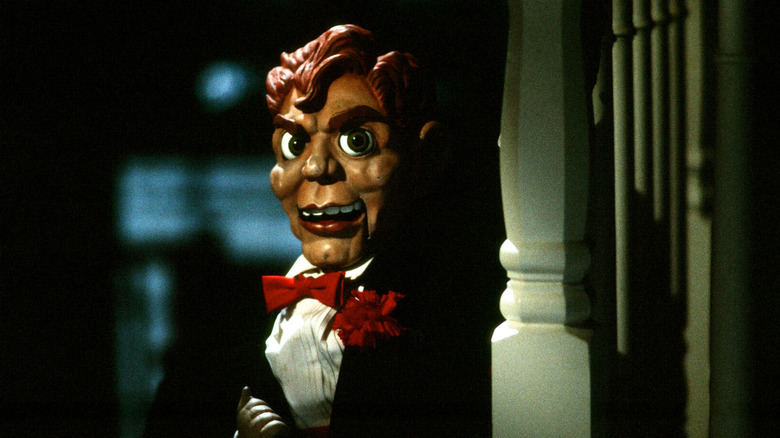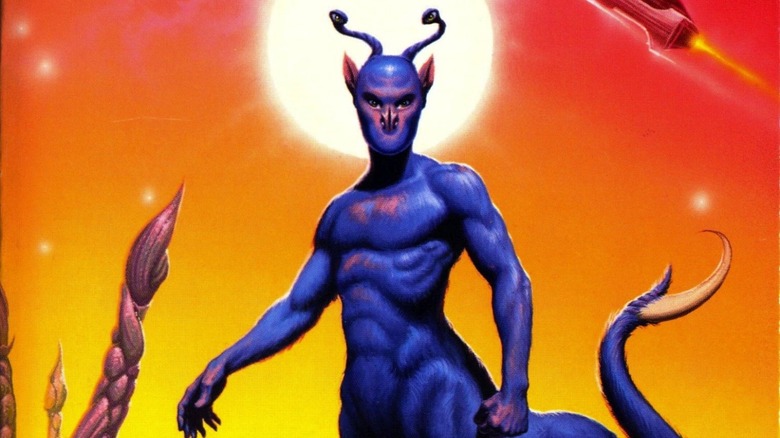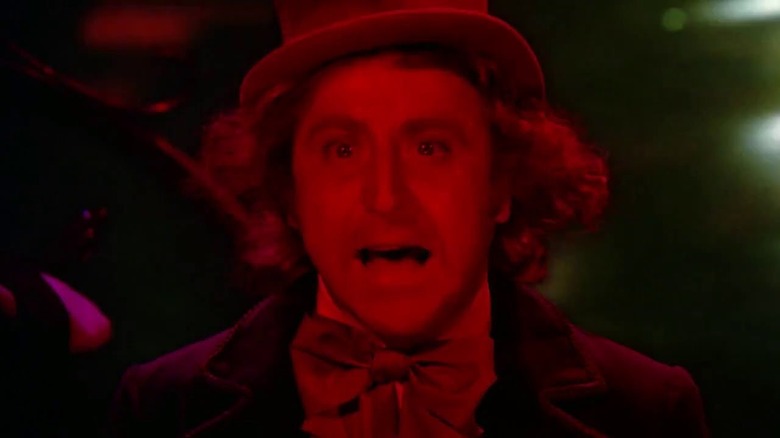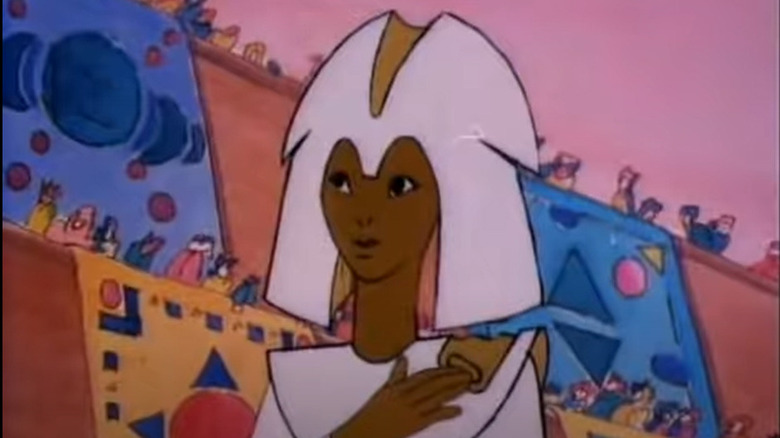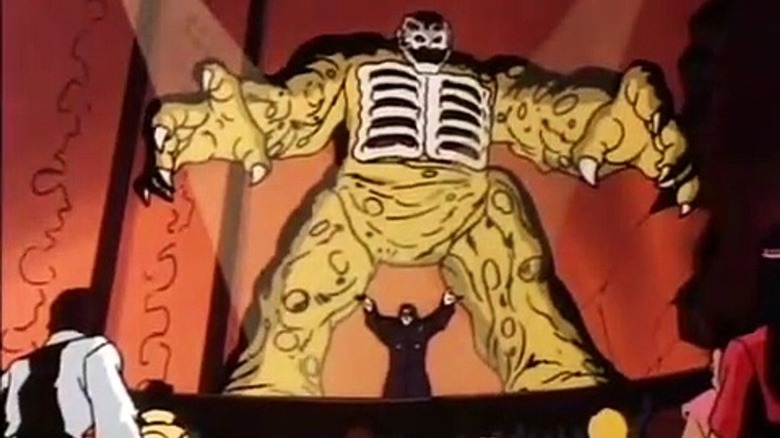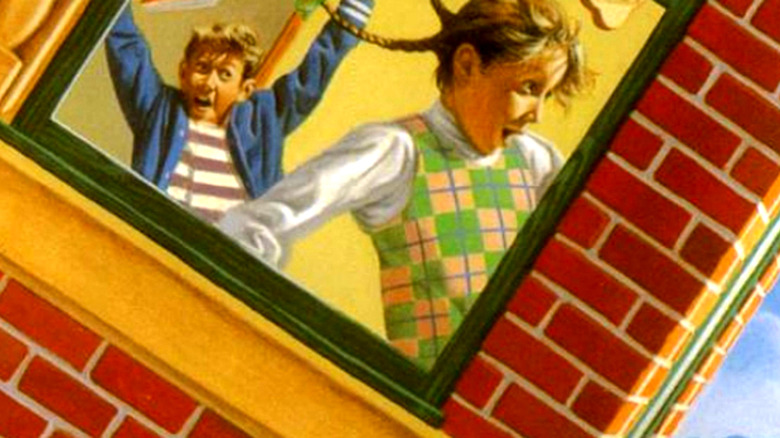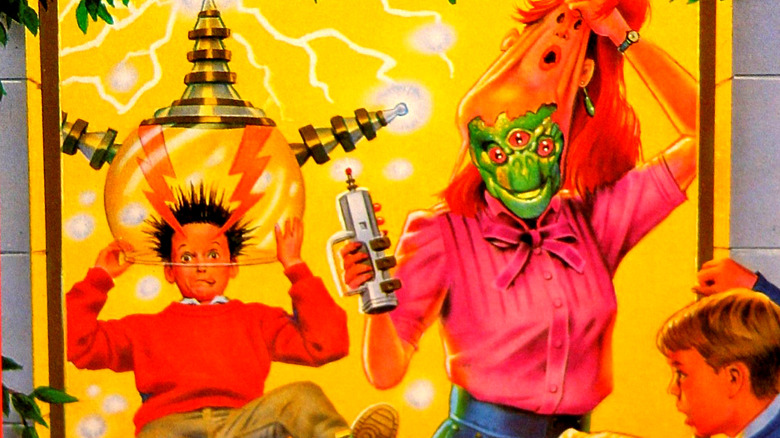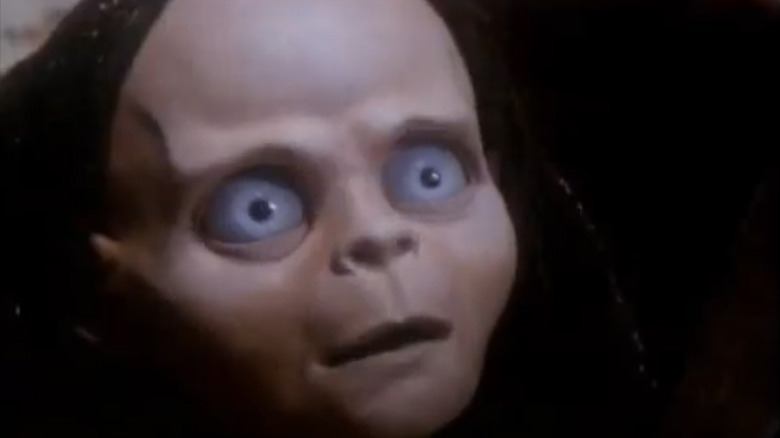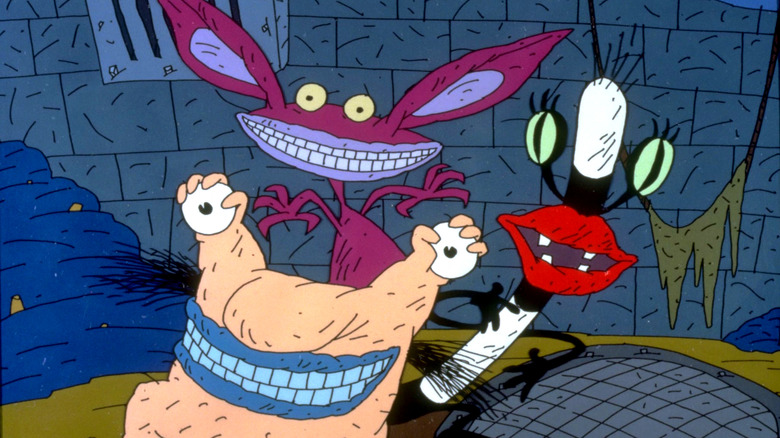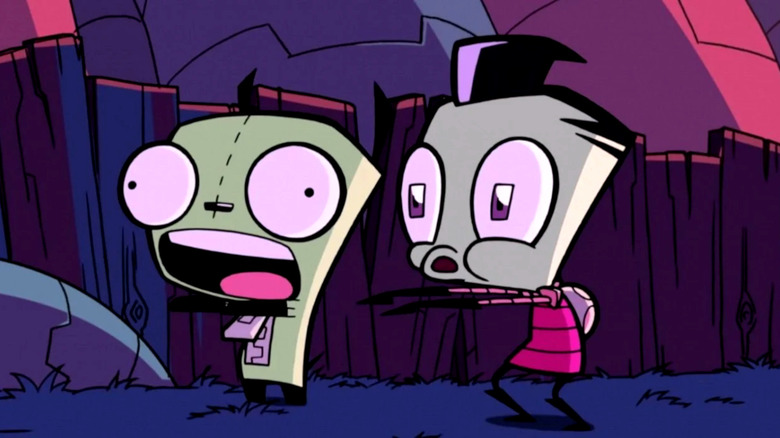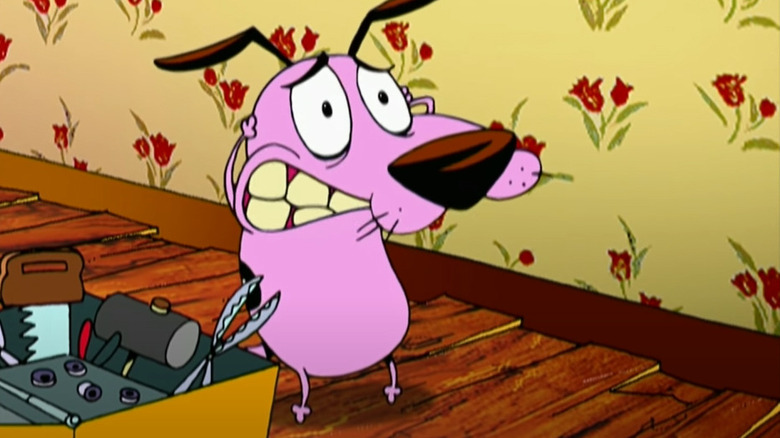Disturbingly Dark Children's Franchises That Scarred Us Forever
Kids are both resilient and impressionable. The weird, creepy, and scary stuff you encounter as a child may not permanently mess you up, but it will stick with you, and might affect what you're scared of for decades to come. Just about all of us have some TV show, movie, or book we encountered at a young age that still haunts us in adulthood. If you grew up in the '80s or '90s, there's certainly a lot you can look back on and wonder, "Why did anyone let us watch that?" Some of these stories simply have surprisingly complex themes kids aren't quite ready for. Other times, though, these productions are just plain messed up.
The last few decades of children's media have been an era of experimentation, defined by pushing the boundaries of what we consider acceptable for little ones to watch. With that in mind, let's take a look back at the children's franchises of our youth that scarred us forever with their disturbingly dark content.
Are You Afraid of the Dark?
This children's horror anthology aired on Nickelodeon for pretty much the entirety of the 1990s. The phrase "children's horror anthology" is strange on its own — it's amazing anybody in 1990 thought it was a good idea. Of course, it did turn out to be a good idea: The show's a classic, and not the only children's horror anthology on this list. But it left a lot of terrified children in its wake (which, one imagines, was the goal).
Most of the stories featured on "Are You Afraid of the Dark?" have happy endings, but the ones that don't really stick with you. "The Tale of the Super Specs," for example, features a pair of magic sunglasses that reveal mysterious black-clad figures nobody else can see. There's something to be said for the horrifying simplicity of an entity with a hidden face, ignored by everyone around them. Other episodes feature disgusting monster make-up, like "The Tale of the Dead Man's Float." If you've seen the episode, you're already picturing its creature in your mind. If you haven't, just know that it's an extremely decayed-looking figure rendered in visceral shades of red.
Then, of course, there are the clowns. "The Tale of the Ghastly Grinner," "The Tale of Laughing in the Dark," and "The Tale of the Crimson Clown" all feature demonic clowns doing dastardly things. Some people blame "It," but actually, this show is responsible for an entire generation's fear of clowns.
Goosebumps
Based on R.L. Stine's book series of the same name, "Goosebumps" ran from 1995 to 1998. If "Are You Afraid of the Dark?" contributed to kids' fear of clowns, "Goosebumps" did the same for ventriloquist dummies. A nasty puppet named Slappy is the series' most famous recurring antagonist, appearing in three episodes of the TV show, as well as both of the more recent "Goosebumps" movies. Slappy is chaotic, sarcastic, and prone to bullying humans into doing his bidding — basically, he acts like most ventriloquist dummies, except he doesn't need a puppeteer's help to act.
Another creepy recurring motif in "Goosebumps" is an evil Halloween mask that can't be taken off. This unfolds in "The Haunted Mask," a book that became a two-part TV episode. If ventriloquist dummies and rubber monster masks didn't scare you as a kid, well, you were braver than most. But "Goosebumps" still has other frights to throw your way. "Stay Out of the Basement," for example, is about an unemployed dad conducting some kind of clandestine experiment. He's starting to seem less and less like himself, which culminates in one of the creepiest endings ever. "The Werewolf Of Fever Swamp" and "The Headless Ghost" are about exactly what the titles imply, and despite being kid-oriented, they don't pull many punches. Whatever you were afraid of as a kid, R.L. Stine was there to push your buttons.
Animorphs
"Animorphs," K.A. Applegate's series of young adult novels, was marketed as being about kids who turn into animals. On one level, that's what it is. But the Animorphs are literally child soldiers who've been recruited into a decades-long war between two alien races. The enemy are the slug-like Yeerks, who take over people's bodies by climbing into their skull and wrapping around their brains. Several members of the Animorphs team watch their family members fall victim to Yeerk possession. On the other side of the conflict are the Andalites, mouthless centaurs who developed the animorphing technology. They're so dedicated to stopping the Yeerks, they'll wipe out whole races rather than let the Yeerks infest them. And yeah, they've thought about doing that to Earth.
Tons of traumatic and terrifying stuff happens in these books. One kid gets trapped in the form of a hawk. Two godlike, Lovecraftian aliens who basically control everything in the galaxy feature, but the good one can't do much to help anybody, because he's locked in a stalemate with the evil one. At one point, the Animorphs recruit a bunch of kids with disabilities and chronic illnesses to become their auxiliary fighters (because the Yeerks are ableist and only invade "perfect" bodies). Then the "good guys" use those kids as cannon fodder. Of course, everyone feels really bad about that. Everyone in these books feels bad about a lot of things. War is hell, even when you can turn into a bear.
Willy Wonka and the Chocolate Factory
1971's "Willy Wonka and the Chocolate Factory" is a classic children's movie set in a magical chocolate factory, so it surely can't be that creepy or traumatizing. Except for that boat ride where Gene Wilder as Wonka recites a creepy poem as horrific images flash on the screen. And the part where Augustus Gloop falls into a river of chocolate, gets caught in a pipe, then shoots out of it like a bullet. And the part where Violet Beauregarde inflates into a giant blueberry. And the part where Mike Teavee is shrunk down to tiny size (possibly permanently?). Veruca Salt, probably the most obnoxious of the children, has the least disturbing fate, as she just falls through a trap door that might lead to a furnace.
The Oompa Loompas, who are racist stereotypes in the original novel, were changed to small-statured men in orange facepaint and green wigs in the movie. Each time one of the children gives into temptation and is eliminated from the factory tour, the Oompa Loompas sing an incredibly judgmental song about them. They manage to equate being a spoiled brat, watching too much TV, chewing gum, and being fat as equally immoral problems for kids to have.
And then there's Willy Wonka himself, an aloof and somewhat amoral figure who turns rude at the drop of a hat and always seems at least a little sinister. Especially during that boat ride. That boat ride is creepy.
Spartakus and the Sun Beneath the Sea
"Spartakus and the Sun Beneath the Sea," or "Les Mondes Engloutis" as it's known in France, ran on Nickelodeon from 1986 to 1987. If you were a kid back then, you might have mistaken it for a fever dream. According to the show's lore, a lost civilization called Arkadia was swallowed by the Earth in the mysterious Great Cataclysm. The Arkadians believed the Cataclysm destroyed all surface life, so they made a new home in the center of the Earth with an artificial sun. Hoping to protect their descendants from attempts to return to the surface, they sealed their archives and went about evolving into legless slug people who become ignorant of their own technology. When their sun starts failing, however, Arkadian kids sneak into the archives and use its technology to create an artificial surface dweller named Arkana.
Arkana journeys to the surface, and soon meets two children, Matt and Rebecca, and a wandering warrior named Spartakus. Also, there's a pair of immortal talking anteaters who are never explained. Together, they journey through the Strata, a series of realms that might be other dimensions that exist between Arkadia and the surface. Oh, and they're being chased by grotesque singing pirates who want to enslave them. Each week, the group travels to some new realm, encounters some wild sci-fi nonsense, and narrowly escapes enslavement. Is it cool? Yes. Did it probably leave a lot of kids with kaleidoscopic nightmares? Also yes.
Inhumanoids
American cartoons of the 1980s were mostly about selling toys. But sometimes, that led to pretty bizarre places, like "Inhumanoids." "Inhumanoids" centers around three kaiju-like monsters who emerge to menace humanity. Metlar, a demonic creature who spits lava, leads the Inhumanoids. Tendril, a plant-based Cthulhu lookalike, can regenerate from even the smallest piece of himself. D'Compose, a partially skeletal, vaguely dinosaur-like creature, turns people into undead monsters with a touch. The only hope of stopping the Inhumanoids is a team of scientists called Earth Corps, who wear brightly colored techno-armor battlesuits. Earth Corps discovers and teams up with a race of elemental beings known as the Mutores, who imprisoned the Inhumanoids in the first place.
Surprisingly, this weird and aggressively toyetic cartoon was also a timely bit of commentary: An amoral businessman named Blackthorne Shore helps to set the Inhumanoids free to further his own goals, while a corrupt senator defunds Earth Corps just as they're needed most. Fortunately, Blackthorne's sister Sandra Shore steps in to privately fund Earth Corps, but then gets turned into an evil monster by D'Compose. On this show, corruption is both figurative and literal.
Perhaps the monsters proved to be a little too scary for a lot of kids (and probably even more parents), as this cartoon and toy line were both short-lived. But for kids who watched D'Compose turn innocent people into hideous monsters with the merest touch of his rotting fingers, the memories are forever.
Wayside School
Louis Sachar's 1978 book "Sideways Stories from Wayside School" was a staple of 1980s school libraries. A number of sequels followed, comprising the "Wayside School" series. An animated television film and show, both called "Wayside," hit the small screen in the 2000s, but those adaptations fail to capture the bizarre menace of the original books.
Wayside is an elementary school in the form of a narrow, 30-story skyscraper, with one classroom on each floor. Except there is no 19th story — that's where Miss Zarves' classroom is, and there is no Miss Zarves. The books focus on the 30th floor classroom, which starts out under the iron rule of Mrs. Gorf, a witch who turns misbehaving children into apples. When a student holds up a mirror at just the right time, Mrs. Gorf accidentally turns herself into an apple. She's eaten by the author's self-insert character, Louis the Yard Teacher.
Mrs. Gorf is replaced by the much nicer Mrs. Jewls, but things stay weird. In one chapter, a new student named Sammy arrives, covered in multiple raincoats. When all his raincoats are forcibly removed, Sammy is revealed to be a dead rat who's trying to sneak in. Not just a rat — a dead rat. In the second book, one student finds herself on the 19th story with Miss Zarves, which turns out to be a purgatory-like space she must escape. That's barely even scratching the surface of the weird and unsettling stuff that happens in these books.
My Teacher is an Alien
Bruce Coville's "My Teacher" books take place in a frightening world. 1989s' "My Teacher Is an Alien" features three kids, Susan, Peter, and Duncan, who discover their teacher Mr. Smith is a green-skinned creature from another world. He plans to take kids back to space with him for an unnamed purpose. His true nature is publicly revealed in the end, but he still manages to escape with Peter. In 1991's "My Teacher Fried My Brains," former bully Duncan finds himself becoming smarter and more thoughtful after he's subjected to a mysterious machine. It turns out to be part of a plot by another secretly extraterrestrial teacher, Miss Karpou, to channel alien messages through his brain.
1991's "My Teacher Glows in the Dark" rejoins Peter, who spends months living on a vast spaceship hidden behind the moon. The iridescent Hoo-Lan becomes his new teacher as he's introduced to an interstellar society. They're debating what to do about the threat of humanity, who they suspect will soon develop interstellar travel and cause chaos with our warlike nature. Finally, in 1992's "My Teacher Flunked the Planet," the three kids have to convince the alien council not to destroy the Earth and let humanity develop in its own time. It's a lot for a trio of kids to handle, but once you've watched multiple teachers pull off their human faces to reveal red-eyed, green-skinned creatures beneath, you're probably ready for anything.
Jim Henson's The Storyteller
1987's "The Storyteller" was created by the legendary Jim Henson. An anthology series based on European folklore, it eschews the classic fairy tales we're used to in favor of more obscure stories, which are often outright terrifying. There are dragons, trolls, witches, and of course Hans My Hedgehog, a nice young man who was born a spiny half-hedgehog because of an offhand remark his mother made. One episode is particularly burned into the brains of everyone who saw it as a child: "The Soldier and Death."
A soldier on his way home from a long war is kind to some beggars. He finds himself gifted with a deck of magical playing cards and a sack that can force anyone or anything inside it. He then finds a castle overrun with devils. Keep in mind, these are Jim Henson Creature Shop devils, meaning they're scary little puppets with rubber faces. He outwits the devils using his magical items, and makes himself rich in the process. Later, he uses the sack to capture Death himself, portrayed as a pale little man with a skull-like face and enormous blue eyes. He's like Gollum from the Peter Jackson "Lord of the Rings" movies, 15 years early. For his meddling with Death and devils, the soldier eventually finds himself unable to die. The story ends with him being left to wander the Earth for all time, a truly unfortunate fate.
Aaahh!!! Real Monsters
"Aaahh!!! Real Monsters" joined the Nicktoons lineup in 1994. Created by Klasky-Csupo, the same team that gave us the distinctive-looking "Rugrats," "Aaahh!!! Real Monsters" rose to new heights of animated hideousness in terms of both linework and subject matter.
The three monsters at the center of this show are Ickis, a twitchy little guy with rabbit ears, Oblina, a vaguely serpentine lady with oversized red lips, and Krumm, a hairy creature with no head who carries his eyeballs in his hands (or occasionally in one hand, if he needs to use the other). They're students at a school for monsters located under a landfill, where Blue Meanie-esque headmaster The Gromble teaches them how to scare humans. Each monster has their own skills for scaring: Ickis grows large, Krumm uses his terrible odor, and Oblina can pull her organs out through her mouth.
The basic premise, you may already be thinking, is somewhat similar to "Monsters, Inc.," which came along a few years later. But while that film is the kind of sweet and likable product you expect from Pixar, "Aaahh!!! Real Monsters" is far more interested in being gross, surreal, and even scary. Moreover, while one of the central jokes of "Monsters, Inc." is that the monsters are actually just as scared of human children, if not more so, as children are scared of them, the "Real Monsters" see humans as targets and relish terrifying them. For a lot of '90s kids, they succeeded.
Invader Zim
Jhonen Vasquez was once best known for an extremely nihilistic comic book called "Johnny the Homicidal Maniac." It's not at all aimed at children, although it certainly appeals to teens who can sneak it past their parents. Regardless, Nickelodeon producer Mary Harrington was impressed with it, and invitred Vasquez to pitch a cartoon. This led to the short-lived '00s icon that is "Invader Zim," which translates Vasquez's anarchic style for the Nicktoons milieu with surprising effectiveness.
The premise of "Invader Zim" is fairly dark. Zim is an advance scout for an evil alien empire who arrives on Earth to gather information for a future invasion. He disguises himself as a human child (although he still has green skin) and attends school, while his robot sidekick GIR disguises himself as a dog. Soon enough, one of Zim's classmates, Dib, sees through Zim's disguise.
One of the most bizarre episodes of "Invader Zim" is "Dark Harvest," in which Zim steals organs from the school's children to put in his own body, in order to fool the school nurse into thinking he's human. He replaces the organs he steals with objects like radiators and video consoles. By the end of the episode, the kids are all mutilated and Zim is hugely bloated with extra organs (although he does fool the nurse). This episode ultimately had a negative impact on the show's reputation when it was discussed during the trial of a teenager who murdered a neighbor. Dark stuff indeed.
Courage the Cowardly Dog
The titular character of "Courage the Cowardly Dog" is a little pink pooch who lives on an isolated farm in a place called Nowhere with his loving, elderly owner Muriel and her grump of a husband, Eustace. In each episode, the trio encounters some sort of monster or villain. Usually, Courage is the only one who grasps the threat they pose. Although he is indeed cowardly, he nevertheless forces himself to deal with each situation out of love for Muriel and a sense of obligation toward Eustace.
What's fascinating about "Courage the Cowardly Dog" is that while it is funny, it also fully embraces its horrific elements. This means it scared a lot of kids just as much as it scares its title character. One memorable installment, "King Ramses' Curse," involves a stolen slab. This leads the skeletal ghost of the titular pharaoh (animated in CGI, no less) to appear on the farm, intoning, "Return the slaaaaab!" as he unleashes curses upon Courage's family. In other episode, "Spirit of the Harvest Moon," the Spirit in question punishes Eustace for being a bad farmer. The Spirit is portrayed as a floating, chalk-white, live-action head.
"Courage the Cowardly Dog" doubtlessly inspired a lasting interest in horror for many kids, serving as a kind of introductory course in the genre. Most likely, that's a purpose a lot of stuff on this list served: Helping scared children grow into adults who enjoy being scared.
